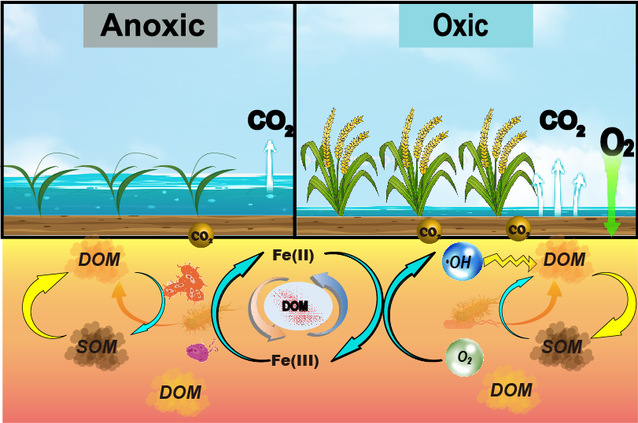
Highlights
– CO2 efflux pulse event explained by nonmicrobial mechanisms mediated by O2.
– ·OH promoted CO2 emission in paddy soil slurries during short-term oxidation.
– Aqueous phase was the main sources of CO2 emission during short-term oxidation process.
– For the DOM, easily biodegradable favors retention after the short-term oxidation.
Abstract: Both biotic and abiotic mechanisms play a role in soil CO2 emission processes. However, abiotically mediated CO2 emission and the role of reactive oxygen species are still poorly understood in paddy soil. This study revealed that ·OH promoted CO2 emission in paddy soil slurries during short-term oxidation (4 h). ·OH generation was highly hinged on active Fe(II) content, and the ·OH contribution to CO2 efflux was 10%–33% in topsoil and 40%–77% in deep-soil slurries. Net CO2 efflux was higher in topsoil slurries, which contained more dissolved organic carbon (DOC). CO2 efflux correlated well with DOC contents, suggesting the critical role of DOC. Microbial mechanisms contributed 9%–45% to CO2 production, as estimated by γ-ray sterilization experiments in the short-term reoxidation process. Solid-aqueous separation experiments showed a significant reduction in net CO2 efflux across all soil slurries after the removal of the original aqueous phase, indicating that the water phase was the main source of CO2 emission (>50%). Besides, C emission was greatly affected by pH fluctuation in acidic soil but not in neutral/alkaline soils. Fourier transform ion cyclotron resonance mass spectrometry and excitation-emission matrix results indicated that recalcitrant and macromolecular dissolved organic matter (DOM) components were more easily removed or attacked by ·OH. The decrease in DOM content during the short-term reoxidation was the combined result of ·OH oxidation, co-precipitation, and soil organic matter release. This study emphasizes the significance of the generally overlooked nonmicrobial mechanisms in promoting CO2 emission in the global C cycle, and the critical influence of the aqueous phase on C loss in paddy environments.
Keywords: Soil; Dissolved organic matter; Abiotically mediated CO2 emission; Reactive oxygen species
DOI: 10.1016/j.eehl.2023.08.005
Authors: Jinsong Liu, Changyin Zhu*, Xiantang Liu, Xiaolei Wang, Dongmei Zhou*